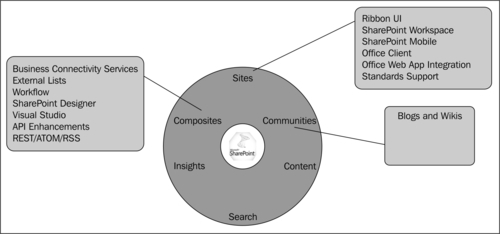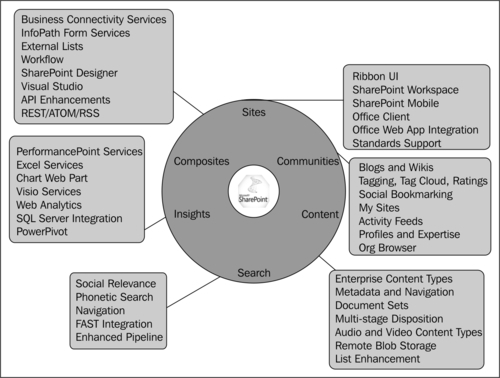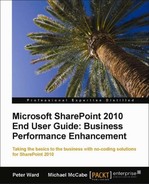From SharePoint 2007 to SharePoint 2010, there have been significant improvements with functionality and the end user's experience. The shortcomings of Office, Outlook, and SharePoint 2007's integration and social aspects have been rectified to provide a Web 2.0 social user experience, and in true Microsoft style, the look and feel of the Office Ribbon is now part of SharePoint's user interface.

With Office 2010, there is tighter integration with the SharePoint product with both user interface and functionality. This functionality includes:
- Outlook Social Connector, which shows SharePoint My Site activity in the Outlook client
- PowerPoint Broadcast service: This feature allows you to broadcast your presentation over the Internet to up to 50 users simultaneously
- Simultaneous editing of Word documents with multiple people
- Opening Office documents in the browser
End users have heard a lot of buzz about SharePoint and it is often difficult to understand what it does out of the box, what is required of the IT department, and what it requires of the development team. Let's look at the technical considerations for an end user in a non-technical manner and demystify the product.
Note
This book is written with the assumption that the end user has Office 2010 with Outlook 2010 deployed on their computer. Earlier versions of Office with Outlook may still perform the same functionally, but the look and feel will be different.
With each new release of SharePoint, there are small changes to the names of the SharePoint technology.

The full name for SharePoint 2007 was Microsoft Office SharePoint Server—MOSS for short. The MOSS part has now been removed in the 2010 release.
SharePoint Foundation, formerly known as WSS, is ideal for smaller organizations or team-oriented web-based collaboration, as well as entry-level document management. The following figure illustrates SharePoint's functionality and what is available with SharePoint Foundation:

This is a free version and is an ideal entry point for an organization that is new to SharePoint and is trying to figure out its functional requirements such as team approvals or issues tracking, rather than a tool that works across the entire organization.
SharePoint Foundation can be used as an extranet.
Some noticeable limitations with Foundation are described in the following sections:
There is a single out-of-the-box predefined workflow available. Additional workflows need to be developed with third-party tools such as SharePoint Designer. SharePoint Designer is free and can be downloaded from the Microsoft website.
The Three state workflow tracks the status of an issue or item through three different states. For example, when a Three-state workflow is initiated on an issue in an Issues list, SharePoint Foundation 2010 creates a task for the assigned user. When the user completes the task, the workflow changes from its initial state (Active) to its middle state (Resolved), and creates a task for the assigned user. When the user completes the task, the workflow changes from its middle state (Resolved) to its final state (Closed), and creates another task for the user that the workflow is assigned to at that time. When you associate the Three-state workflow with a list, you can choose to specify different state names other than Active, Resolved, and Closed.
The search functionality is limited to individual team sites rather than a Google-style search engine, which can make suggestions with your search, find similar results, or sort by relevance. Search functionality could be enhanced with the free Search Server Express.
Although users can add web parts to pages, there are no My Site features that allow greater personalization of user behavior job function. This functionality is explained later in this book.
This edition is ideal for:
- Integrating Office documents within SharePoint
- Evaluating a technology without committing to software license purchases
- Simple business processes such as workflows and forms
- Basic collaboration
SharePoint Server is an extension of SharePoint Foundations functionalities, which are illustrated in the following diagram:

For larger organizations with more demanding collaboration requirements, SharePoint Server is more ideal as out-of-the-box functionality. SharePoint Server has two editions, which are described in the following section.
This has the core SharePoint capabilities to manage content and business processes and personalization and search functionality.
This edition is ideal when there is a need for:
This edition has the functionality of the Standard Edition and also provides integration with Microsoft Office client for rich data visualization, dashboards, and analytics through Excel and Access services as well as InfoPath forms.
This edition is ideal for:
- Integrating information from different systems to the end user in a web-based environment
- Displaying business intelligence information
- Extending data from the web into Excel
- Using web-based InfoPath forms that need to be filled out in the browser
Note
Both the Standard and Enterprise editions have the same workflow ability, enterprise search and personalization, and content targeting features.
In this section, you can see that the out-of-the-box functionality increases from Foundation to Enterprise. If an organization has more than 50 employees and wishes to standardize business process with the SharePoint technology, we would recommend the Enterprise edition. This recommendation may increase software license and hardware costs, but the additional out-of-the-box functionality provided will bring a beneficial ROI to the business.
A SharePoint Editions Comparison is detailed in Appendix A.
